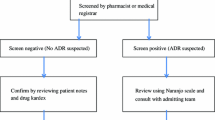Abstract
Background: The incidence of adverse drug reaction (ADR)-related hospitalisations has usually been assessed within hospitals. Because of the variability in results and methodology, it is difficult to extrapolate these results to a national level.
Objectives: To evaluate the incidence and characteristics of ADR-related hospitalisations in The Netherlands in 2001.
Methods: We conducted a nationwide study of all hospital admissions in 2001. Data were retrieved from a nationwide computer database for hospital discharge records. All acute, non-planned admissions to all Dutch academic and general hospitals in 2001 were included in the study (n = 668 714). From these admissions we selected all hospitalisations that were coded as drug-related, but intended forms of overdose, errors in administration and therapeutic failures were excluded. Hence, we extracted all ADR-related hospitalisations. We compared age, sex and the risk of a fatal outcome between patients admitted with ADRs and patients admitted for other reasons, as well as the most frequent main diagnoses in ADR-related hospitalisations and which drugs most frequently caused the ADRs. In addition, we evaluated to what extent these ADRs were reported to the Netherlands Pharmacovigilance Centre Lareb for spontaneous ADR reporting.
Results: In 2001, 12 249 hospitalisations were coded as ADR related. This was 1.83% of all acute hospital admissions in The Netherlands (95% CI 1.80, 1.86). The proportion increased with age from 0.8% (95% CI 0.75, 0.85) in the <18 years group to 3.2% in the ≥80 years group (95% CI 3.08, 3.32). The most frequent ADR-related diagnoses of hospitalisations were bleeding (n = 1048), non-specified ‘unintended effect of drug’ (n = 438), hypoglycaemia (n = 375) and fever (n = 347). The drugs most commonly associated with ADR-related hospitalisations were anticoagulants (n = 2185), cytostatics and immunosuppressives (n = 1809) and diuretics (n = 979). Six percent of the ADR-related hospitalisations had a fatal outcome (n = 734). Older age and female gender were associated with ADR-related hospitalisations. Only approximately 1% of the coded ADRs causing hospitalisation were reported to our national centre for spontaneous ADR reporting.
Conclusion: The proportion of ADR-related hospitalisations is substantial, especially considering the fact that not all ADRs may be recognised or mentioned in discharge letters. Under-reporting of ADRs that result in hospital admission to our national centre for spontaneous ADR reporting was considerable.




Similar content being viewed by others
References
Roughead EE, Gilbert AL, Primrose JG, et al. Drug-related hospital admissions: a review of Australian studies published 1988-1996. Med J Aust 1998; 168(8): 405–8
Lazarou J, Pomeranz BH, Corey PN. Incidence of adverse drug reactions in hospitalized patients: a meta-analysis of prospective studies. JAMA 1998; 279(15): 1200–5
Muehlberger N, Schneeweiss S, Hasford J. Adverse drug reaction monitoring-cost and benefit considerations. Part I: frequency of adverse drug reactions causing hospital admissions. Pharmacoepidemiol Drug Saf 1997; 6(S3): S71–7
Beijer HJ, de Blaey CJ. Hospitalisations caused by adverse drug reactions (ADR): a meta-analysis of observational studies. Pharm World Sci 2002; 24(2): 46–54
Pirmohamed M, James S, Meakin S, et al. Adverse drug reactions as cause of admission to hospital: prospective analysis of 18 820 patients. BMJ 2004; 329(7456): 15–9
Onder G, Pedone C, Landi F, et al. Adverse drug reactions as cause of hospital admissions: results from the Italian Group of Pharmacoepidemiology in the Elderly (GIFA). J Am Geriatr Soc 2002; 50(12): 1962–8
Routledge PA, O’Mahony MS, Woodhouse KW. Adverse drug reactions in elderly patients. Br J Clin Pharmacol 2004; 57(2): 121–6
Pouyanne P, Haramburu F, Imbs JL, et al. Admissions to hospital caused by adverse drug reactions: cross sectional incidence study. French Pharmacovigilance Centres. BMJ 2000; 320(7241): 1036
International Classification of Diseases. 9th Rev. Clinical modification (ICD-9-CM). Michigan: Commission on Professional and Hospital activities, 1978
van Grootheest AC. Improving pharmacovigilance and the role of the pharmacist. [PhD dissertation]. Groningen: University of Groningen, 2003
Alvarez-Requejo A, Carvajal A, Begaud B, et al. Under-reporting of adverse drug reactions: estimate based on a spontaneous reporting scheme and a sentinel system. Eur J Clin Pharmacol 1998; 54(6): 483–8
Eland IA, Belton KJ, van Grootheest AC, et al. Attitudinal survey of voluntary reporting of adverse drug reactions. Br J Clin Pharmacol 1999; 48(4): 623–7
Nelson KM, Talbert RL. Drug-related hospital admissions. Pharmacotherapy 1996; 16(4): 701–7
Mannesse CK, Derkx FH, de Ridder MA, et al. Contribution of adverse drug reactions to hospital admission of older patients. Age Ageing 2000; 29(1): 35–9
Mjorndal T, Boman MD, Hagg S, et al. Adverse drug reactions as a cause for admissions to a department of internal medicine. Pharmacoepidemiol Drug Saf 2002; 11(1): 65–72
Hallas J, Haghfelt T, Gram LF, et al. Drug related admissions to a cardiology department; frequency and avoidability. J Intern Med 1990; 228(4): 379–84
Williamson J, Chopin JM. Adverse reactions to prescribed drugs in the elderly: a multicentre investigation. Age Ageing 1980; 9(2): 73–80
Davidsen F, Haghfelt T, Gram LF, et al. Adverse drug reactions and drug non-compliance as primary causes of admission to a cardiology department. Eur J Clin Pharmacol 1988; 34(1): 83–6
Carbonin P, Pahor M, Bernabei R, et al. Is age an independent risk factor of adverse drug reactions in hospitalized medical patients? J Am Geriatr Soc 1991; 39(11): 1093–9
Lassila HC, Stoehr GP, Ganguli M, et al. Use of prescription medications in an elderly rural population: the MoVIES Project. Ann Pharmacother 1996; 30(6): 589–95
Straand J, Rokstad KS. Elderly patients in general practice: diagnoses, drugs and inappropriate prescriptions. A report from the More & Romsdal Prescription Study. Fam Pract 1999; 16(4): 380–8
Roughead EE, Gilbert AL, Primrose JG, et al. Coding drug-related hospital admissions in the medical record: is it adequate for monitoring the quality of medication use? Aust J Hosp Pharm 1998; 28: 7–12
Acknowledgements
None of the authors have a conflict of interest and this research was not supported by external funds.
Author information
Authors and Affiliations
Corresponding author
Rights and permissions
About this article
Cite this article
van der Hooft, C.S., Sturkenboom, M.C., van Grootheest, K. et al. Adverse Drug Reaction-Related Hospitalisations. Drug-Safety 29, 161–168 (2006). https://doi.org/10.2165/00002018-200629020-00006
Published:
Issue Date:
DOI: https://doi.org/10.2165/00002018-200629020-00006




